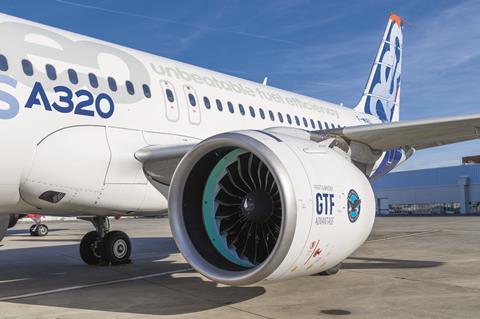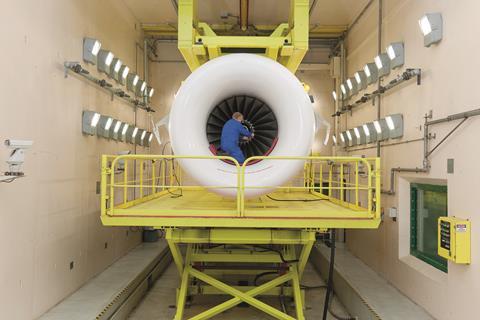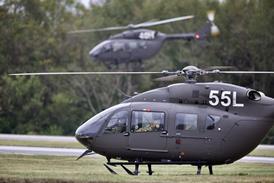It may have been the military Wasp that propelled Pratt & Whitney into the aviation engine business a century ago, but the company helped give birth to the early airline industry and has been by its side ever since. Pratt & Whitney engines have provided the power for passenger aircraft from the pioneering pre-war transoceanic Martin M-130 clippers of Juan Trippe’s Pan American to icons of the jet age from the Boeing 707, 727 and 747 to the Douglas DC-9, and Airbus A300.

While Pratt & Whitney’s long heritage in the widebody arena is impressive thanks to influential and innovative products such as the JT9D and its PW4000 successor, the business’ commercial aviation focus today is firmly on single aisle, the largest and fastest growing segment in the market. That was confirmed by the landmark decision 18 years ago to launch a clean-sheet design, the GTF, offering a step change in performance for a new generation of narrowbody aircraft.
Pratt & Whitney has been a major player in single aisle with the V2500 from International Aero Engines – a consortium originally founded with Rolls-Royce, MTU and Japanese Aero Engines Corporation (JAEC). The engine was and remains an option on the original Airbus A320 family, launched in 1984 as a rival to the Boeing 737. However, the GTF was the first engine to bring a revolutionary geared architecture into commercial service.

The GTF, formally unveiled after years of research, began development and testing in 2008 as the engine for the then-Mitsubishi Regional Jet (later known as the Space Jet). It has had a remarkable impact on the industry, precipitating a range of new airframe offerings. Available on all Airbus A320neo sibling aircraft as the PW1100G-JM, it is additionally the exclusive powerplant on two other new-generation, smaller-narrowbody families, with the PW1900G powering the E190-E2 and E195-E2 from Embraer and the PW1500G on the Airbus A220.
“Commercial aviation has always played a vital role for Pratt & Whitney, and that is certainly true today, where the GTF is the most fuel-efficient engine on the market,” says Rick Deurloo, president, commercial engines. “There is a strong demand for the product, with more than 11,000 orders delivered or in the backlog to 90 customers, and a book to bill greater than one.”

That accounts to an expanding fleet of 2,300 aircraft powered by an engine that represents, as Deurloo describes it, “truly game-changing technology.” The GTF, he says, offers up to 20% fuel efficiencies over aircraft powered by its predecessors, amounting to a seven billion litre fuel saving over the nine years it has been in service. It also has a 75% smaller noise footprint. “People just love how quiet the engine is,” declares Deurloo.
Pratt & Whitney has continued to invest in the engine, with the first major iteration to the PW1100G-JM for the Airbus A320neo family – the GTF Advantage – certificated by US regulators in February, with European Union Aviation Safety Agency approval expected to follow in the second half of this year. GTF Advantage engines will start rolling off the production line later this year, with an option to introduce most of its durability improvements into in-service engines through the MRO network in 2026.
The GTF Advantage adds a series of benefits to an already transformative engine, according to Deurloo. These include a 4% improvement in take-off thrust at sea level, rising to 8% at high altitude airports, enabling customers to operate at higher payloads and longer ranges. “The GTF already has a leading position when it comes to fuel burn,” he says. “Now we are taking that further.”
The other major change with the GTF Advantage – which is fully interchangeable and intermixable with the current PW1100G-JM – is in terms of its durability, says Deurloo. GTF Advantage includes fully redesigned life-limited parts and technology enhancements throughout the gas path. Increased airflow to the core lowers operating temperatures, while a new “state of the art” hot section also helps boost time on wing. In the high-pressure turbine (HPT), enhancements include an advanced airfoil design with improved coatings.

The HPT and combustor also feature changes to the cooling hole size, shape and location, with water jet – as opposed to laser – hole drilling techniques reducing oxidation. “It’s a much cleaner, tighter process that really allows for more durability,” says Deurloo, a veteran of Pratt & Whitney’s former parent United Technologies, who took on his current role in 2022.
The GTF Advantage went through extensive endurance testing to ensure all technologies are fully mature at entry into service. It also benefits from more than 100,000 hours of engine and rig testing across all GTF programmes and some 40 million flight hours of in-service operation.
Another feature of the GTF Advantage is that it has been successfully tested with 100% synthetic aviation fuel (SAF). The trial – carried out in March 2022 – is a significant step towards ensuring compatibility with future specifications for 100% SAF, which are being defined by industry standards body ASTM International. “Having the engine 100% SAF-capable at entry into service is something we are really proud of,” says Deurloo. “It builds on many years of work testing our engines with alternative fuels, which are set to be increasingly important for our industry and customers.”
Retrofit
The business also plans to introduce a GTF Advantage retrofit to base line PW1100Gs starting next year, with 90-95% of the GTF Advantage durability improvements made available to existing operators.
The GTF Advantage will really come into its own on the Airbus A321XLR. “The XLR opens a new chapter in connectivity, enabling new routes and city pairs, and the Advantage is especially well-suited for it. When Airbus came to us looking for the Advantage, it was very much with the XLR in mind,” says Deurloo. “Globally we have 13 customers that have selected the GTF on the A321XLR, and we’re excited to see what they do with it.”
While much of Pratt & Whitney’s attention is on its latest generation narrowbody engine, the GTF’s predecessor, the V2500, continues to play an important role in the business, and is in limited production both as the sole power option on the Embraer C-390 Millennium military transporter and as spare engines for A320ceo family aircraft. The V2500 was also chosen for the now out-of-service McDonnell Douglas MD-90.
“The V2500 powers our business through the aftermarket” says Deurloo. “It has world-class durability, reflected in the fact that the fleet has just passed the huge milestone of 300 million flight hours, and the high-time engine with 43,000 hours of service was recently removed for service since its installation in 2013. The fleet has an average age of only 15 years so there is still a lot of life left in the programme. There are around 2,800 [V2500-powered] aircraft flying with more than 150 operators. It’s an amazing success story.”

Supporting the engine – which was launched in 1983, certified in 1988, and entered service on an Adria Airways A320 the following year – is what Deurloo describes as “an incredible MRO network” comprising 13 facilities around the world, that support more than 800 shop visits a year.
Deurloo pays credit to these MRO partners but also those who have collaborated industrially with Pratt & Whitney since before the launch of the V2500 and have continued to play a key role on the GTF engine. These include MTU, the Munich-based specialist which assembles one third of all PW1100G-JM engines.
Other key GTF partners include Japanese giants IHI Corporation, Mitsubishi Heavy Industries and Kawasaki Heavy Industries, along with South Korea’s Hanwha, Spain-based ITP Aero and Sweden’s GKN. “We have benefitted from these industrial partnerships for more than 50 years,” says Deurloo. “They are fully integrated into our network, both in terms of OEM capabilities and MRO capacity.”
For nearly two years, Pratt & Whitney has been undergoing an extensive GTF engine recall to inspect and replace if necessary certain components manufactured from powdered metals. An increase in MRO capacity, which is expected to grow by more than 30% this year, will continue to accelerate through the second half of the decade, and has been a “critical factor” in addressing delays. “AOG [aircraft on ground] levels have stabilized and we expect them to reduce steadily throughout this year,” says Deurloo.
Future plans
However, the arrival of the Avantage variant on the market both as a new engine and a retrofit option will also play a crucial role in keeping engines on wing. GTF Advantage engines will come with longer life-limited parts (LLPs) and are not expected to require off-wing maintenance for up to twice as long as baseline PW1100G-JMs, Pratt & Whitney says.
Although Airbus and Boeing are keeping their cards close to their chest on replacements for the A320neo and 737, Deurloo insists Pratt & Whitney’s commercial propulsion business – and the wider RTX – is “well positioned to provide solutions” as the airframers consider their future product strategies for the next decade and beyond. “We continue to look at technologies such as composite fan blades, and smaller cores, using CMCs [ceramic matrix composites] in engines, as well as hybrid-electric propulsion,” he says.
However, evolving the business’ breakthrough GTF know-how could also be crucial. “Why do we feel so strongly about this?” asks Deurloo. “Because by the time we come to the mid-2030s, there will have been 250 million hours flown on the GTF architecture.” He concludes: “We are focused on delivering on our commitments today, but we very much have an eye on that late-2030s to 2040s timeframe. We’re excited about the future and we will be ready.”
Pratt & Whitney at 100

To mark the centenary of Pratt & Whitney, FlightGlobal has partnered with RTX to produce a souvenir special looking at the legacy and future of one of the industry’s most powerful and influential brands.
- 1
- 2
- 3
- 4
 Currently
reading
Currently
reading
Pratt & Whitney at 100: Commercial Engines – single minded
- 6
- 7
- 8
- 9
- 10
- 11
- 12
- 13


















































